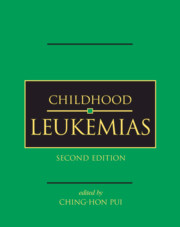Book contents
- Frontmatter
- Contents
- List of contributors
- Preface
- Part I History and general issues
- Part II Cell biology and pathobiology
- Part III Evaluation and treatment
- 14 Pharmacokinetic, pharmacodynamic, and pharmacogenetic considerations
- 15 Assays and molecular determinants of cellular drug resistance
- 16 Acute lymphoblastic leukemia
- 17 Relapsed acute lymphoblastic leukemia
- 18 B-cell acute lymphoblastic leukemia and Burkitt lymphoma
- 19 Acute myeloid leukemia
- 20 Relapsed acute myeloid leukemia
- 21 Myelodysplastic syndrome
- 22 Chronic myeloproliferative disorders
- 23 Hematopoietic stem cell transplantation
- 24 Acute leukemia in countries with limited resources
- 25 Antibody-targeted therapy
- 26 Adoptive cellular immunotherapy
- 27 Gene transfer: methods and applications
- 28 Minimal residual disease
- Part IV Complications and supportive care
- Index
- Plate Section between pages 400 and 401
- References
18 - B-cell acute lymphoblastic leukemia and Burkitt lymphoma
from Part III - Evaluation and treatment
Published online by Cambridge University Press: 01 July 2010
- Frontmatter
- Contents
- List of contributors
- Preface
- Part I History and general issues
- Part II Cell biology and pathobiology
- Part III Evaluation and treatment
- 14 Pharmacokinetic, pharmacodynamic, and pharmacogenetic considerations
- 15 Assays and molecular determinants of cellular drug resistance
- 16 Acute lymphoblastic leukemia
- 17 Relapsed acute lymphoblastic leukemia
- 18 B-cell acute lymphoblastic leukemia and Burkitt lymphoma
- 19 Acute myeloid leukemia
- 20 Relapsed acute myeloid leukemia
- 21 Myelodysplastic syndrome
- 22 Chronic myeloproliferative disorders
- 23 Hematopoietic stem cell transplantation
- 24 Acute leukemia in countries with limited resources
- 25 Antibody-targeted therapy
- 26 Adoptive cellular immunotherapy
- 27 Gene transfer: methods and applications
- 28 Minimal residual disease
- Part IV Complications and supportive care
- Index
- Plate Section between pages 400 and 401
- References
Summary
Introduction
B-cell acute lymphoblastic leukemia (B-cell ALL) has historically accounted for approximately 2% of childhood ALLs diagnosed in the United States each year. This malignancy has clinical, histologic, immunophenotypic, and cytogenetic features similar to those of Burkitt lymphoma, a high-grade B-cell non-Hodgkin lymphoma (NHL). Hence, B-cell ALL and Burkitt lymphoma are usually considered to represent a spectrum of the same disease process. In children, the distinction between Burkitt lymphoma with bone marrow involvement and B-cell ALL is arbitrarily based on the degree of marrow infiltration. Patients who have less than 25% replacement of normal marrow with lymphoblasts are considered to have advanced (stage IV) Burkitt lymphoma, whereas those with more extensive marrow replacement are given the diagnosis of B-cell ALL. These two groups are treated with the same protocols used for patients with advanced-stage Burkitt lymphoma that has not disseminated to the marrow (stage III). Although limited-stage Burkitt lymphoma is also thought to be included in this disease spectrum, it is less common in children than are the advanced forms and is treated with much less intensive therapy. Hence, in describing treatment, we will focus on stages III and IV Burkitt lymphoma and B-cell ALL.
Advances in our understanding of the molecular pathogenesis of these malignancies and improvements in treatment outcome have been striking over the past 20 years. Currently, a 75% to 85% event-free survival rate can be expected for children with B-cell ALL. By contrast, less than 50% of these patients were event-free survivors 20 years ago.
- Type
- Chapter
- Information
- Childhood Leukemias , pp. 487 - 498Publisher: Cambridge University PressPrint publication year: 2006
References
- 1
- Cited by



